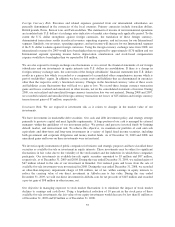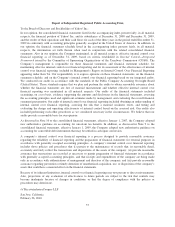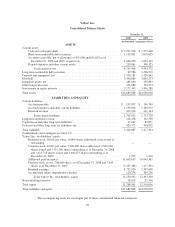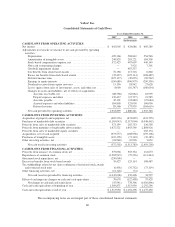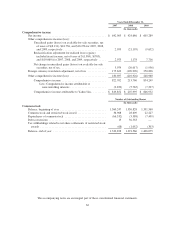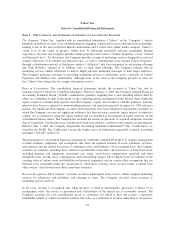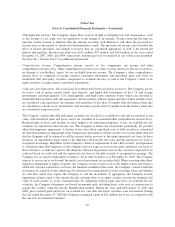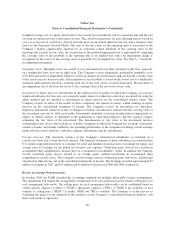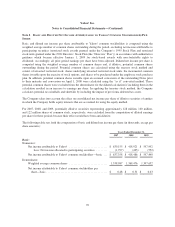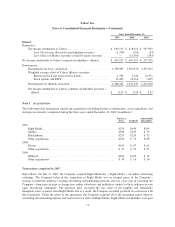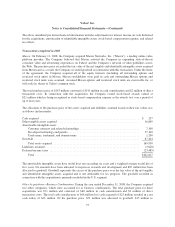Yahoo 2009 Annual Report Download - page 73
Download and view the complete annual report
Please find page 73 of the 2009 Yahoo annual report below. You can navigate through the pages in the report by either clicking on the pages listed below, or by using the keyword search tool below to find specific information within the annual report.Yahoo! Inc.
Notes to Consolidated Financial Statements—(Continued)
termination benefits are expensed at the date the entity notifies the employee, unless the employee must provide
future service, in which case the benefits are expensed ratably over the future service period; and (iii) costs to
terminate a contract before the end of its term are recognized when the entity terminates the contract in
accordance with the contract terms. In addition, a portion of the Company’s restructuring costs related to
international employees whose termination benefits are recognized when the amount of such termination benefits
becomes estimable and payment is probable.
These restructuring initiatives require management to make estimates in several areas including: (i) realizable
values of assets made redundant, obsolete or excessive; (ii) expenses for severance and other employee
separation costs; and (iii) the ability to generate sublease income, and to terminate lease obligations at the
estimated amounts.
Allowance for Doubtful Accounts. The Company records its allowance for doubtful accounts based upon its
assessment of various factors. The Company considers historical experience, the age of the accounts receivable
balances, the credit quality of its customers, current economic conditions, and other factors that may affect
customers’ ability to pay to determine the level of allowance required.
TAC. TAC consist of payments made to Affiliates and payments made to companies that direct consumer and
business traffic to Yahoo! Properties. The Company enters into agreements of varying duration that involve
TAC. There are generally two economic structures of the Affiliate agreements: fixed payments based on a
guaranteed minimum amount of traffic delivered, which often carry reciprocal performance guarantees from the
Affiliate or variable payments based on a percentage of the Company’s revenue or based on a certain metric,
such as the number of searches or paid clicks. The Company expenses, as cost of revenues, TAC under two
different methods. Agreements with fixed payments are expensed ratably over the term the fixed payment covers.
Agreements based on a percentage of revenue, number of searches, or other metrics are expensed based on the
volume of the underlying activity or revenue multiplied by the agreed-upon price or rate.
Product Development. Product development expenses consist primarily of compensation related expenses
(including stock-based compensation expense) incurred for research and development, the development of,
enhancements to, and maintenance and operation of Yahoo! Properties, advertising products, technology
platforms, and infrastructure. Depreciation expense, third-party technology and development expense, and other
operating costs are also included in product development.
Advertising Costs. Advertising production costs are recorded as expense the first time an advertisement appears.
Costs of communicating advertising are recorded as expense as advertising space or airtime is used. All other
advertising costs are expensed as incurred. Advertising expense totaled approximately $220 million, $190
million, and $197 million for 2007, 2008, and 2009, respectively.
Stock-Based Compensation Expense. The Company recognizes stock-based compensation expense net of an
estimated forfeiture rate and therefore only recognizes compensation costs for those shares expected to vest over
the service period of the award. Stock-based awards granted on or after January 1, 2006 are valued based on the
grant date fair value of these awards; the Company records stock-based compensation expense on a straight-line
basis over the requisite service period, generally one to four years.
Calculating stock-based compensation expense requires the input of highly subjective assumptions, including the
expected term of the stock options, stock price volatility, and the pre-vesting forfeiture rate of stock awards. The
Company estimates the expected life of options granted based on historical exercise patterns, which the Company
believes are representative of future behavior. The Company estimates the volatility of its common stock on the
65


